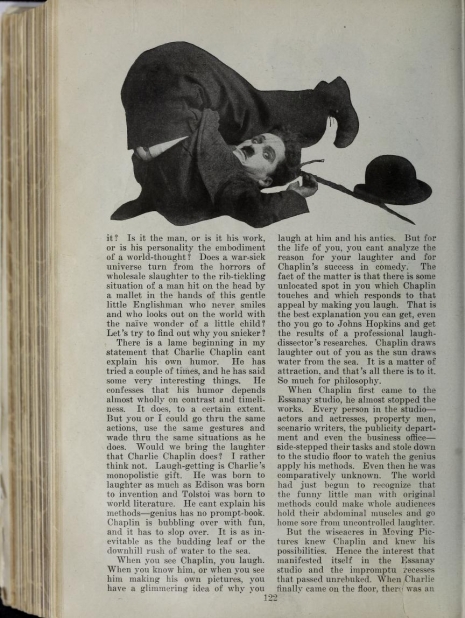
There are some ideas that are so irresistible that mind gravitates towards them whether they’re true or not. For instance, you’ve probably heard it said more than once that you can boil a frog by increasing the temperature slowly over a period of time, and the frog will not notice and neglect to jump out in time. It isn’t true, but that will do nothing to prevent you from hearing it several more times, I’ll wager. Similarly, the idea that Eskimos have some preposterous number of terms to describe snow is, at best, a highly contested one, but something that comes up a lot as well.
Another such idea is that Charlie Chaplin failed to win a Charlie Chaplin lookalike contest. I’ve been hearing this one for many years—I think it was actually featured on a Trivial Pursuit card back in the ‘80s—but I’ve always wondered what the truth was.
What’s for certain is that the necessary ingredients for such a tale did exist. In other words, Chaplin’s first movie successes around 1914 sparked a worldwide phenomenon called “Chaplinitis,” in which audiences simply could not get enough of his winsome Little Tramp character. For later generations the obvious comparison is the Beatlemania that hit in 1963 and 1964. It seems incontestable that Chaplin was the first authentic mass media phenomenon, quite possibly the one against which all others must be judged.
The power of Chaplin rested in part on the ability of the newish technology of motion pictures to resonate instantly among mass audiences—there was no barrier to entry whatsoever. As Charles Silver writes in his MoMA monograph Charles Chaplin: An Appreciation, “No particular level of sophistication or even literacy was necessary ... to see that he was special; you only had to see.”

Dozens of Chaplin Imitators standing in front of The Liberty Theater, Bellingham, Washington, 1921
Here’s J. Hoberman on Chaplin-mania in a piece that appears in his marvelous collection Vulgar Modernism:
That spring, however [referring to 1915], Chaplinitis swept the English-speaking world. By now Chaplin was his own trademark; the tramp was totally industrialized. There were Chaplin songs, Chaplin dances, Chaplin sketches in theatrical revues, Chaplin cocktails, Chaplin dolls, Chaplin shirts, Chaplin ties, Chaplin postcards, Chaplin animated cartoons, and a Chaplin comic strip. It was as if a new religion had been born and everyone wanted a piece of the cross. Placed beneath a marquee, the cardboard image of the little man with the skimpy mustache—his silhouette rendered indelible by bowler hat, baggy pants, and outsized shoes—was sufficient in itself to fill a theater. Demand far outstripped supply. The 26-year-old actor could not produce movies quickly enough to satisfy his fans.
-snip-
So many comedians were impersonating Chaplin on the screen—among them, Stan Jefferson (subsequently Laurel)—that Charlie had to file suit. It was said that for a time costume balls were ruined, because 90 per cent of the men appeared dressed as the Little Tramp. (In The Idle Class, Chaplin attended one such ball dressed as himself.)
America definitely had Chaplin on the brain. In Cincinnati, a holdup man used a Charlie Chaplin disguise. In a mysterious occurrence on November 12, 1916, the actor was simultaneously paged in 800 hotels.
So clearly, there were Chaplin contests during this era. According to Dan Colman of Open Culture, The Straits Times of Singapore ran a story in August 1920 under the title “How Charlie Chaplin Failed,” that includes the following passage:
Lord Desborough, presiding at a dinner of the Anglo-Saxon club told a story which will have an enduring life. It comes from Miss Mary Pickford who told it to Lady Desborough, “Charlie Chaplin was one day at a fair in the United States, where a principal attraction was a competition as to who could best imitate the Charlie Chaplin walk. The real Charlie Chaplin thought there might be a chance for him so he entered for the performance, minus his celebrated moustache and his boots. He was a frightful failure and came in twentieth.
“He was a frightful failure and came in twentieth.” A year later an Australian newspaper repeated the story only with Chaplin finishing 27th.
It’s intriguing that the story even in this telling is reported third-hand—if not fourth-hand—and why is Singapore a solid origin for a story like this anyway? To his credit, Colman includes information that undermines his headline, stating that a representative from the Association Chaplin, when pressed, recently commented that there are “no other references to such a competition in any other press clipping albums that I have seen.”
In comments to the Open Culture article, Jeffrey Vance, author of the 2003 book Chaplin: Genius of the Cinema, states that he uncovered a 1966 interview in which Chaplin himself denied the story in no uncertain terms:
Chaplin stated emphatically in the 1966 interview that the legend was not true and had no basis in fact. “In the first place,” Chaplin explained. “I’m working hard all day. I certainly don’t want to do that.”
So that’s that. As Hoberman noted, Chaplin did address the matter, in a way, in his 1921 short The Idle Class, in which the Tramp (as always being pursued by unfriendly cops) crashes a high-class costume party simply by walking through the front door. You can watch the movie below:
Here’s a three-page item called “Chaplinitis” by a writer named Charles J. McGuirk that was published in Motion Picture Magazine in 1915; it’s available in PDF format at the Internet Archive.




Previously on Dangerous Minds:
Charlie Chaplin: Color photographs on set as the Little Tramp, 1917-18